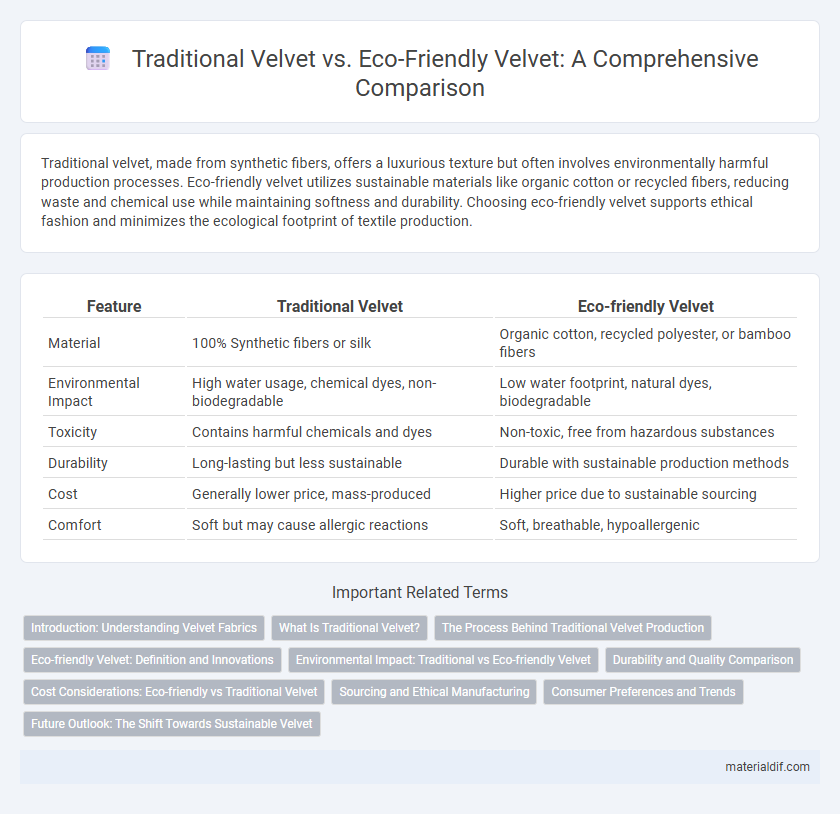Traditional velvet, made from synthetic fibers, offers a luxurious texture but often involves environmentally harmful production processes. Eco-friendly velvet utilizes sustainable materials like organic cotton or recycled fibers, reducing waste and chemical use while maintaining softness and durability. Choosing eco-friendly velvet supports ethical fashion and minimizes the ecological footprint of textile production.
Table of Comparison
| Feature | Traditional Velvet | Eco-friendly Velvet |
|---|---|---|
| Material | 100% Synthetic fibers or silk | Organic cotton, recycled polyester, or bamboo fibers |
| Environmental Impact | High water usage, chemical dyes, non-biodegradable | Low water footprint, natural dyes, biodegradable |
| Toxicity | Contains harmful chemicals and dyes | Non-toxic, free from hazardous substances |
| Durability | Long-lasting but less sustainable | Durable with sustainable production methods |
| Cost | Generally lower price, mass-produced | Higher price due to sustainable sourcing |
| Comfort | Soft but may cause allergic reactions | Soft, breathable, hypoallergenic |
Introduction: Understanding Velvet Fabrics
Traditional velvet fabric is typically made from silk, cotton, or synthetic fibers, characterized by its dense pile and luxurious texture. Eco-friendly velvet, often crafted from sustainable materials like organic cotton, recycled polyester, or bamboo, offers a similar soft feel while minimizing environmental impact. Understanding the fiber content, production methods, and ecological footprint is essential in distinguishing traditional velvet from its sustainable counterparts.
What Is Traditional Velvet?
Traditional velvet is a luxurious fabric characterized by its dense pile and soft texture, typically made from natural fibers such as silk, cotton, or rayon. It involves a weaving process that creates short, cut threads standing upright, resulting in its signature plush surface and rich appearance. Often associated with high-end fashion and upholstery, traditional velvet is prized for its durability and elegant sheen but can have a significant environmental footprint due to the resource-intensive production methods.
The Process Behind Traditional Velvet Production
Traditional velvet production involves weaving silk or cotton fibers on a special loom to create the fabric's distinctive dense pile, requiring significant water and energy consumption. The dyeing process often uses synthetic chemicals that can lead to environmental pollution and toxic waste. This method results in luxurious texture but raises concerns about resource-intensive practices and ecological impact.
Eco-friendly Velvet: Definition and Innovations
Eco-friendly velvet is a sustainable textile made from organic fibers, recycled materials, or innovative plant-based alternatives that reduce environmental impact compared to traditional velvet, which typically uses synthetic fibers and chemical-heavy processes. Advances in eco-friendly velvet production include natural dyeing techniques, water-saving manufacturing methods, and biodegradable fibers that maintain the luxurious texture and durability consumers expect. Brands prioritizing eco-friendly velvet contribute to reducing pollution, lowering carbon footprints, and fostering circular fashion economies.
Environmental Impact: Traditional vs Eco-friendly Velvet
Traditional velvet production relies heavily on synthetic fibers and chemical dyes, resulting in significant water pollution and high energy consumption. Eco-friendly velvet utilizes organic materials and natural dyes, reducing carbon footprint and minimizing toxic waste discharge. Sustainable manufacturing practices in eco-friendly velvet contribute to preserving water resources and lowering greenhouse gas emissions compared to conventional methods.
Durability and Quality Comparison
Traditional velvet, often crafted from silk or synthetic fibers, offers a luxurious texture but may wear down faster under frequent use due to its delicate fibers. Eco-friendly velvet, typically made from recycled or sustainably sourced materials like organic cotton or bamboo, tends to balance softness with enhanced durability and environmental responsibility. Quality assessments reveal that eco-friendly velvet maintains colorfastness and pile integrity longer, making it a practical choice without compromising on elegance.
Cost Considerations: Eco-friendly vs Traditional Velvet
Traditional velvet typically incurs lower upfront costs due to established manufacturing processes and abundant raw materials, making it more affordable for mass production. Eco-friendly velvet, crafted from sustainable fibers and utilizing environmentally conscious methods, often involves higher initial expenses that reflect ethical sourcing and reduced environmental impact. Long-term cost considerations for eco-friendly velvet include potential savings through durability and consumer demand for sustainable products, balancing its premium price point against traditional velvet's lower base cost.
Sourcing and Ethical Manufacturing
Traditional velvet is typically made from synthetic fibers or cotton sourced through conventional farming, which often involves chemical pesticides and intensive water use. Eco-friendly velvet prioritizes sustainable materials such as organic cotton, bamboo, or recycled fibers, sourced from certified farms adhering to strict environmental standards. Ethical manufacturing practices in eco-friendly velvet production emphasize fair labor conditions, reduced waste, and minimized carbon footprint, contrasting with the less regulated supply chain of traditional velvet.
Consumer Preferences and Trends
Consumer preferences increasingly favor eco-friendly velvet over traditional velvet due to growing awareness of sustainability and environmental impact. Eco-friendly velvet, often made from recycled or organic fibers, aligns with trends toward ethical fashion and reduced carbon footprints. Market data shows a rise in demand for sustainable textiles, signaling a shift in purchasing behavior favoring eco-conscious velvet options.
Future Outlook: The Shift Towards Sustainable Velvet
The future outlook for velvet is increasingly defined by the shift towards eco-friendly velvet, driven by growing consumer demand for sustainability and ethical production. Traditional velvet, often made from synthetic fibers and intensive manufacturing processes, faces challenges due to its environmental impact and reliance on non-renewable resources. Innovations in biodegradable materials and responsible sourcing are positioning sustainable velvet as the preferred choice, promising reduced carbon footprints and enhanced market viability.
Traditional Velvet vs Eco-friendly Velvet Infographic

 materialdif.com
materialdif.com